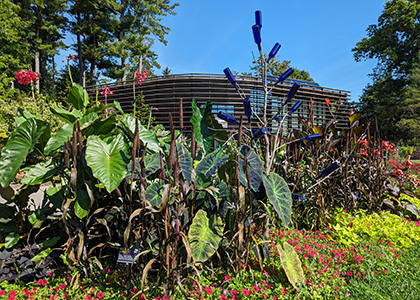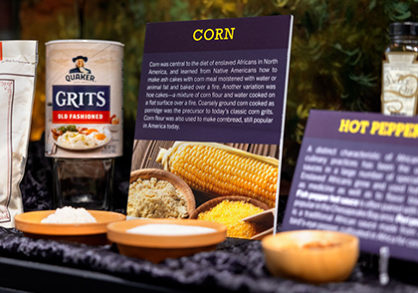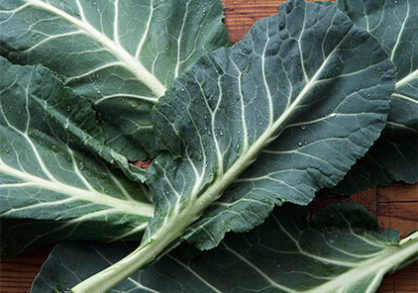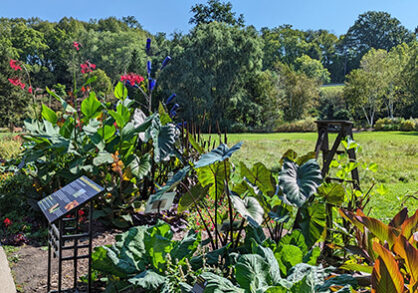
Cultivating the plants of “Seeds of Survival and Celebration: Plants and the Black Experience.”
Growing the plants of “Seeds of Survival and Celebration” has been a humbling and intimately transformative experience. We gained insight into a rich diversity of seed savers and sellers, historical resources, and contemporary growers—and we only scratched the surface. The combined research of our education team, horticulture team, and advisory group resulted in a constant dialogue that wove a tapestry of discoveries, often making us giddy with excitement to grow plants we did not know and learning new properties of plants we did. As plant people do, we each developed new relationships: obsession with Motherland Okra, fascination with African basil, adoration for blue sesame, and new depths of appreciation for the complex relationship enslaved Africans had with cotton as not only a cash crop, but as medicine and a powerful tool of resistance.

We emerged from the process with a list of plants that not only bring history and contemporary narratives to life, but that also meet important logistical parameters for successful botanical storytelling: they are plants we can identify, source, and (sometimes creatively) cultivate here in our central New York climate. Our learning did not end with the creation of the list. We have continued to gain deeper knowledge of these species and varieties as we grow them from seed to harvest and have adapted our selection, cultivation practices, and exhibit content in this second year and for next year’s display. Some of the challenges (and joys) have been identifying which taxa are historically accurate, sourcing the seeds, and successfully propagating and growing through a north temperate summer.
Many of the taxonomic details of plants grown by enslaved Africans were not accurately captured in formats that are accessible today: a fact that made it challenging to pinpoint the exact “wild sage” that was used for curing maladies like coughs, sore throats, diarrhea, and skin wounds. African American Slave Medicine by Herbert Covey, an invaluable resource based on the Works Project Administration (WPA) interviews conducted with former enslaved people in the 1930s, misidentified several plants. Wild Sage was described in this book as Salvia officinalis, which is indigenous to the Mediterranean and unlikely to become wild in the humid deep south. Many sages (Salvia spp.) have medicinal properties, but the details are nebulous. Further contributing to the confusion, Lantana camara has numerous medicinal properties and uses, grows wild in the southern U.S., and is commonly called “wild sage,” but isn’t technically a sage at all! Through meticulous research and help from generous colleagues at the North Carolina Botanical Garden, we were finally able to deduce and successfully grow the correct species: Salvia lyrata.

African rice was among the slave ship provisions during the grueling ocean crossing from Africa to the Americas and was grown in domestic gardens to supplement the basic food rations issued on plantations. For a key plant whose botanical nomenclature was well known, we struggled to find a reliable seed source for this African rice, Oryza glaberrima. The success of the more common Asian rice species Oryza sativa, one of the commercial cash crops that drove the slave trade in the Americas, depended on the skill and knowledge of the enslaved West African rice farmers whose ancestors domesticated the red bearded upland rice over 3,000 years ago. To find seed of the true African rice, we reached out to Cornell’s world-renowned rice expert: Dr. Susan McCouch, Professor of Plant Breeding and Genetics, and Research Support Specialist Sandra Harrington. They generously donated seeds that were originally imported from the International Rice Research Institute seed bank in the Philippines. We successfully grew a small crop in a container, but the plants did not produce viable seeds by the end of the season.

Enter Truelove Seeds, a seed company dedicated to preserving and sharing culturally important and open pollinated vegetable, herb, and flower seeds. In our second year, we expanded the display and added nearly 100 new taxa. We discovered Truelove Seeds stunning African Diaspora collection, which includes a beautiful heritage Hill Rice from Trinidad that has been cultivated for over two-hundred years by descendants of enslaved Africans. Interestingly, this rice has performed much better in our New York summer than Asian rice.
One of the iconic, significant African plant species that we longed to include in the exhibit is African yam (Dioscorea cayennensis subsp. rotundata). In the Americas, enslaved Africans discovered that the native sweet potato (Ipomea batatas) possessed similar properties to the yams they had cultivated for centuries. While superficially alike, they are not closely related botanically. We wanted to grow both to offer a comparison. Species of Asian yams can be found more readily, but the true African yam proved difficult to source. Both attempts to order from commercial suppliers ended in sadly rotten tubers upon arrival. Attempts to connect with other botanic gardens that might be able to share germplasm were dead ends. We were thrilled to find African yams in a local grocery store – but alas, they (like most tubers, such as potatoes) had been treated with sprout suppressant and could not be coaxed to grow. Throughout the growing season, the shelf-stable grocery store African yam sat cozily in the display case in the Welcome Center while sweet potatoes thrived in the rich soil of the Pounder Vegetable Garden across the street – at least offering visual aids to begin the conversation. But the story does not end there. Our astute Interpretation Coordinator noticed one day in late summer that the stoic yam was beginning to sprout! Thanks to a rapid response by our plant production team, the yam was moved to a pot in the greenhouse and exploded in a profusion of growth. Hopefully, it will overwinter there under glass and emerge next spring to be featured in our third and final year of the exhibition.

Ultimately, many of the plants that we were able to successfully grow—heirloom varieties of collard greens, okra, millet, peppers, tomatoes, watermelons and many more—came from the wonderfully diverse holdings of small but mighty, independently-owned seed companies: Truelove Seeds, Southern Exposure Seed Exchange, Sistah Seeds and Monticello. Exploring their catalogues is an inspiring journey through generations of survivors: both seeds and people. We hope that by exhibiting these storied plants that we elevate and celebrate the voices of the thousands of Africans and their descendants who saved, cultivated, and continue to grow these seeds of survival.

Emily Detrick is the Elizabeth Weaver director of horticulture for Cornell Botanic Gardens
Seeds of Survival and Celebration
This garden and exhibit tell stories of the deep connections of the formerly enslaved to plants and illustrate their contributions to the cuisines enjoyed across American society today.
Honoring black culture through plants
Explore the plants included in “Seeds of Survival and Celebration: Plants and the Black Experience.”
Seeds of Survival and Celebration returns to honor Black history, knowledge, and culture
The exhibition returns with an expanded plant collection, more stories, and vernacular garden features reflective of African American culture.


